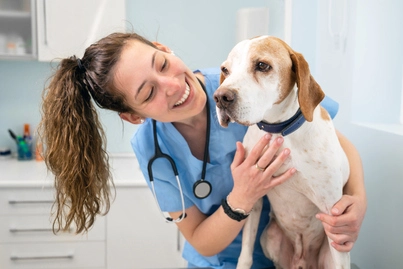When your dog is uncomfortable, it can make you uncomfortable. Not only because you’re seeing your baby suffering, but it can be distracting to everyone’s routine.
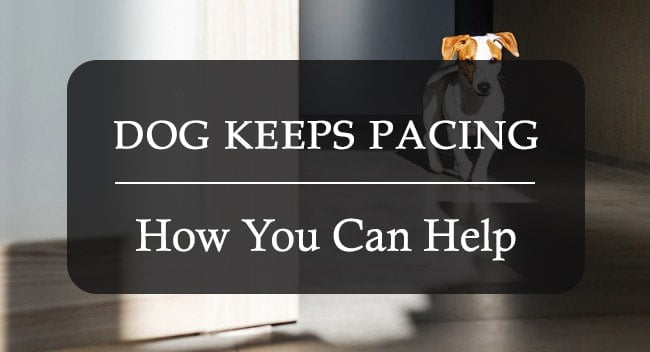
Your dog could be walking laps around the kitchen table or wandering from room to room.
It’s troubling to ponder why your otherwise healthy dog won’t settle down.
You might not want to take a costly trip to the vet right away. But you also want to rule out serious dog health issues that could be affecting your four-legged loved one.
There are a whole host of reasons you’re saying my dog is pacing and won’t lie down, and you might not be sure which one is the culprit.
We’re here to answer the riddle: why is my dog pacing?
Contact a Vet
If your dog needs medical intervention, plenty of things can be done for them under the guidance of a vet. Alternatively, you can quickly chat with a vet online now, which is both a cost and time savings.
Connect with a verified veterinarian in minutes. No waiting for appointments or office hours. No high fees. Your pet's health made convenient and worry-free.
Beyond your immediate concerns, there is good news.
Pacing is a common behavior in dogs and usually has easy solutions, so here are a few for you to consider.
What Could Be the Reason for Your Dog Pacing and Not Lying Down?
So precisely why do dogs pace? There is no one-size-fits-all answer to that nagging question.
Various factors must be considered before trying to diagnose the reason: age, breed, and size of your dog could all be relevant.
You also should take into consideration any past or current health issues your dog has.
If they haven’t received a diagnosis, there are a few warning signs you should look for.
In addition to pacing, injured or arthritic dogs could display uncharacteristic aggression. Look out for unexplained swelling, as well as changes in appetite.
One of the core reasons your dog paces is because your dog can’t get comfortable. Discomfort can range from physical to psychological, even in canines.
No matter how pronounced your dog’s pacing is, it’s essential to understand the cause – it could be an easy fix or a more serious condition.
Anxiety
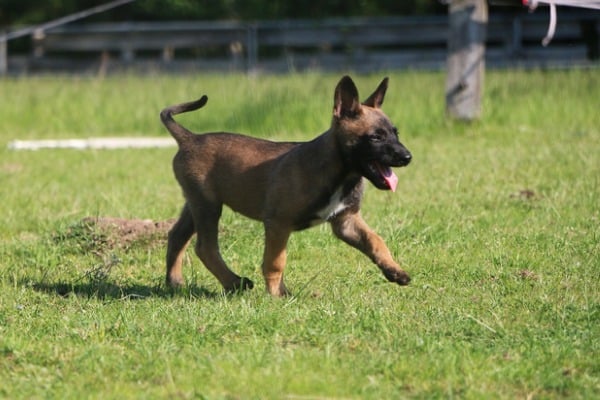
Anxiety is more common in dogs than some might think. And its symptoms can mirror those of human anxiety.
What do you do when you’re anxious? Do you find it hard to sit still? Your dog might, too.
Anxious dogs might not be able to sit for more than a few seconds at a time, or they might randomly pace. Just like with humans, anxiety has different levels in dogs.
Properly-adjusted dogs feel safe in their home.
A safe house and regular daily schedule usually result in an anxiety-free environment for a dog. However, slight changes to their surroundings or schedule can lead to anxiety.
When your dog keeps pacing and won’t lie down, that can be a warning sign of anxiety disorder.
Let’s go over some of the additional signs and symptoms.
Signs and Symptoms
Anxiety disorder in dogs is challenging to diagnose. A number of the symptoms are more intense versions of normal behavior.
Owners must recognize a pattern of changed behavior over time.
There is an array of symptoms that may be caused by anxiety. Here are some of the most common:
- Continuous pacing
- Is restless at night and won’t settle down
- Panting
- Whimpering
- Hiding
- Trembling or shivering as if cold
- Dislike of eye contact
- Repeatedly tries to leave the area
- Avoidance of petting
- May stand on you if you sit or lie down
- Dog not sleeping
Affected Breeds
Anxiety disorder can develop in any breed of dog. However, some breeds are more likely to develop the condition.
Here are some of the breeds that most commonly have anxiety issues:
- German Shepherd
- Australian Shepherd
- Labrador
- Vizslas
- Border Collie
- Cocker Spaniel
- Bichon Frise
- King Charles Spaniel
- Greyhound
- Toy Breeds
Many times the breed of the dog has nothing to do with the presence of anxiety.
Remember, the dog’s owner, training, environment, physical health, and several other factors contribute to the development of anxiety.
What can you do?
You can do more to help a dog with anxiety problems than most other health conditions.
Do what it takes for your dog to always have a safe, static environment. This includes making sure they have a regular daily routine and schedule.
Changes to a dog’s routine or environment should be done gradually, if possible.
Taking a dog to a new place and meeting new people or new animals every day can provoke anxiety.
This video touches on further treatments for treating anxiety in canines.
You should definitely seek the advice of a veterinarian when anxiety problems are having an effect on the dog’s quality of life, the owner’s quality of life, and before the anxiety-driven behavior has gone on for an extended amount of time.
If the irregular behavior is allowed to continue over a long time, it will be more difficult to correct.
They Need to Go Outside
This problem often has the easiest solution. Your dog might be pacing because she needs to relieve herself.
The first thing you want to try is letting them eliminate outdoors. Sometimes, busy schedules cause us to slip with our dogs’ routines.
A pacing dog might simply be telling you, “I need to go outside!” If they’re pacing to and from the door, it’s time to let them out.
They Need Attention
Dogs are social animals. And they rely on their humans to fulfill a lot of socialization needs.
Your dog might simply want to play or have lost their favorite ball under the couch. They could be telling you they need some contact – dogs enjoy attention just like we do.
Humans have learned to read dogs by evolving alongside them for so long. Pay attention to the cues your dog is giving you; sometimes, the solution is as simple as a scratch behind the ears.
We will cover more on this a bit later…
Their Usual Sleeping Place Needs an Upgrade
We replace and clean our bedding frequently. The exact needs to be done for your dog’s bed.
Their bed might be a special blanket, a dog pillow, or even a space on your own bed. But if something isn’t right with their space, they won’t want to settle down in it.
They’re Feeling Territorial
Dogs can resource guard when they feel threatened. They might guard food, a toy, or their entire domain.
A dog who feels their safe space is being encroached upon might be literally on guard by pacing. They feel they have to protect their zone.
They Want a W-A-L-K
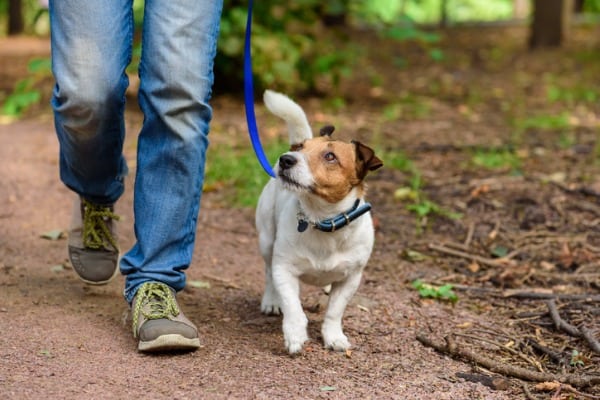
Sometimes, a dog can want to go outside for another reason other than to use the bathroom. Walks or other forms of exercise are vital to a dog’s health.
A pacing dog could be a dog with pent-up energy. If they’re stuck inside a lot, especially if it’s a small space, it will make them restless.
Arthritis
This is more frequently seen in older dogs, but it can also happen to younger ones. Certain breeds can be more genetically predisposed to arthritis.
If your dog’s source of discomfort is arthritis, it will be hard for them to find a suitable resting position. The pacing could be a form of relief from aching joints.
Something Caught Their Attention
It’s no secret that dogs have a keen sense of smell. They can detect anything from drugs to cancer with their noses.
Their hearing is more sensitive than ours, too. They can hear further than humans and at higher-pitched frequencies.
Your dog could be smelling or hearing something you’re completely unaware of. It could be another animal, a person, or just the wind.
But a new smell or sound is the canine equivalent of a disturbance in the force. A dog who senses something might pace out of nervousness or excitement.
Injury or Illness
No one wants their fur baby to be feeling poorly, which is why pacing is something you should monitor carefully. A sick dog could pace out of discomfort or pain.
We’ll cover more below on possible illnesses that could be at play.
There could also be an injury to blame. Dogs can’t help themselves if they’re hurt. The pacing could be from pain or also to communicate they need your help.
Sundowners Syndrome
If you’ve been around elderly humans, you know that age-induced dementia symptoms can amplify in the evening. Well, canines aren’t immune to dementia or sundowners syndrome.
Elderly dogs might show extra confusion at nighttime. They can become forgetful and disoriented, just like their aging human counterparts.
Love Is In the Air

Or at least pheromones might be. The pacing could be a symptom of a female dog coming into heat.
Similarly, if you have an unaltered male dog, detecting a nearby female in heat could also cause him to pace. In fact, it might cause him to act unusually agitated.
Remember when we talked about how well dogs can smell? They can smell each other too – especially when they know there’s a, shall we say, special someone walking the neighborhood.
Changes in the House
An anxious dog might be trying to adapt to something. It could be a new pet (or human) sibling, a new house, or visitors.
Even new neighbors could cause your dog to become anxious. If they have pets of their own, your dog could be hearing, smelling, and seeing new animals.
Changes in routine can trigger anxiety too. If you’ve changed your work schedule, your dog might experience some anxiety trying to adapt to the new regimens.
Anxious dogs might do more than just pace. They could become destructive towards furniture, toys, and your rose garden.
Be aware of your dog taking out their frustrations on innocent squeaking toys. Also, be on the lookout for signs of separation anxiety.
Heat Cycles
If you have an unspayed female dog, pacing could signal she’s about to come into heat. The clearest indicator of heat in female dogs is bloody discharge.
She might seem more restless in general. Heat can also cause frequent urination, which is expected during the cycle.
Male dogs who are aware of a female in heat might become agitated themselves. He might even try to escape to find the nearby female.
What Other Symptoms Should You Look For?
To help narrow down the cause of your dog’s pacing, keep your eyes (and ears) open for additional signs. Your dog could be displaying a variety of symptoms, and it’s essential to pay attention to them.
There could be other things in your dog’s surroundings that can help pinpoint why they’re pacing. Take into consideration some environmental factors that might be contributing to the cause.
Bathroom Troubles
Your dog will need to be let outside to use the bathroom several times a day; 3 – 5 times a day is normal. Any more than that could signal a urinary or intestinal issue.
If your dog is pacing to the door to signal, they need to eliminate more than every few hours, they need to see a vet. If an otherwise house-trained dog has accidents inside, it could be further proof they are having some sort of internal distress.
Loose stools, diarrhea but otherwise normal, or traces of blood are all signs of serious problems that require a vet’s attention.
Frequent, bloody, or foul-smelling urine are sign of a urinary infection and must also be treated by a vet promptly.
Connect with a verified veterinarian in minutes. No waiting for appointments or office hours. No high fees. Your pet's health made convenient and worry-free.
Dog Talk

Dogs can whine, bark, and make a variety of unique noises (husky parents, anyone?). They often do so to try to communicate with us.
A dog who wants your attention might bark playfully, whine, or make growl-like noises that aren’t aggressive.
They might paw you or assume the familiar “play bow” to indicate they want playtime with you.
Bedding Complaints
Your dog might not be settling down in their bed because something is amiss with it.
You might observe them trying to scratch and dig at their bedding. They may even pee on their bed right in front of you to let you know they are stressed about something.
They could also abandon an otherwise prized spot altogether. If your dog suddenly dislikes their usual spot, they’ll seek a different place to sleep.
Border (Collie) Patrol
Dogs who are guarding their safe space could become aggressive. Keep a close watch on their body language; are they showing any “guarding” signs?
Dogs who feel crowded could bark or growl at people or pets who come too close.
They could become extra protective of family members, food bowls, and beds.
Pay close attention to a dog who feels they are being intruded upon.
Most dogs will give ample warning before they lash out – ignoring these warnings isn’t good for anyone.
A dog looking around frantically or acting unusually dominant could feel threatened.
Zoomies
It’s cute – not to mention hilarious – when your dog does a speedy “zoomies” circuit around the park.
If they’re doing it inside, it could be an indication they want to burn off some energy.
Zoomies has a scientific term: Frenetic Random Activity Periods, or FRAPs. When pacing evolves into a case of FRAPs, it’s an outlet for pent-up energy.
Stiffness and Slowed Pace
Especially older dogs slow down as a result of arthritis. They could take more time sitting, lying, and standing.
If they’re allowed on furniture, you might notice they have trouble jumping up on the bed or couch. They could be avoiding stairs as well.
Some tell-tale signs of arthritis is whimpering and yelping at the touch of the affected area. They also could excessively lick their joints.
On Alert
When dogs smell or hear something unusual, they will often try to find the source.
Pacing because they smelled something could turn into a sniffing adventure.
A dog that hears a new sound will wander toward where they think it’s coming from. They frequently will “head tilt” as they try to figure out what they’re hearing.
When a dog is pacing because of a new smell or sound, they will almost always appear on alert. Their ears will be perked up, and sometimes they will stop and listen for the sound they hear.
Limping
A limp might not be indicative of arthritis. Active dogs can sprain joints and strain muscles, just like humans can.
If they pace and favor one leg, one thing you can check for yourself is an injury to the paw pad.
Sharp objects or even snow can become embedded and cause your dog pain and discomfort.
Small foreign objects lodged between your dog’s toes aren’t usually a cause for concern.
If there are any lacerations involved, it’s best to call your vet for further advice.
If you can’t find anything wrong with your dog’s paws, there could be a bone or ligament injury.
This is something that should be diagnosed by a vet right away – excessive pacing can exacerbate the problem in the meantime.
Confusion
Dogs can indeed experience senility in old age. When your dog reaches their senior years, pacing could be a byproduct of dementia.
Your dog might pace and seem lost. They could wander into areas of your home that they usually avoid.
What Kinds of Dogs Are More Vulnerable?
Some dogs are more prone to pacing. Age, history, medical conditions, and breed can all affect whether or not your dog paces.
If your dog falls into one of the following categories, it could help provide some answers as to why they can’t sit still.
Elderly Dogs
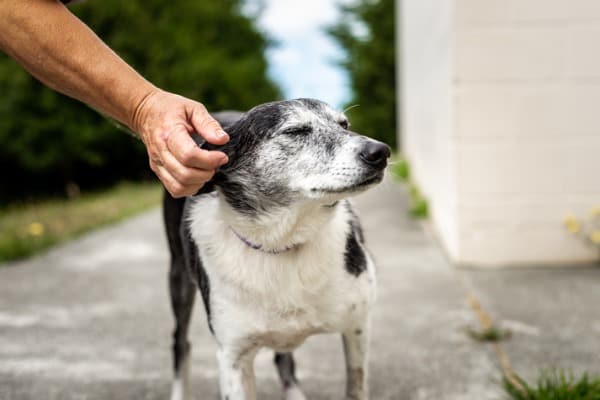
They’re more likely to have arthritis and other medical issues.
Any medical condition has the potential to cause discomfort, and discomfort often manifests itself with walking up and down and generally pacing around.
Canine Cognitive Disorder
Canine Cognitive Disorder (CCD) is also known as “dog dementia.” This disorder is often compared to Alzheimer’s disease in humans. Although they are not the same, they do share several similarities.
Research backs up the statement that CCD will almost always present itself in older dogs.
The symptoms tend to appear gradually and increase in severity over time. Perhaps your elderly dog keeps pacing, won’t lie down, seems confused or disoriented, or presents other behavioral changes.
All aspects of a dog’s cognitive functions or mental processes can be affected by CCD.
Some of these essential cognitive functions include: memory, awareness, perception, judgment, and many others.
When an older dog won’t stop pacing or is restless at night over time, these can be early warning signs of canine cognitive disorder.
What else should you look for here?
As stated previously, all elderly dogs are susceptible to CCD. Additionally, the condition affects every canine differently.
Here are some of the most frequently reported symptoms of this condition:
- Decreased vision, hearing, or loss of appetite and not eating
- Dog pacing or wandering
- Challenged to move around familiar areas
- Confusion
- Restless during the night
- Increased anxiety symptoms
Numerous other symptoms can be caused by CCD. Any significant behavioral change in an elderly dog should be taken seriously.
Affected Breeds
There is no specific breed that’s more susceptible to CCD than others. Veterinary medicine experts estimate that CCD affects 12%-14% of dogs aged over 10 years.
It is believed that CCD is more common in smaller dog breeds because they tend to have longer lifespans than older breeds.
What can you do?
Owners can help with consistent behavioral practice. Veterinarians recommend that owners retrain dogs with CCD, keep them active and stimulated, and have a regular daily routine in place.
Mental stimulation is thought to be the best method for slowing the progression of CCD.
So, owners should try to give their dogs every possible opportunity to use their brain, like: an exercise regimen, games, and training.
No, pacing around doesn’t count! We’re looking for healthy activities here, such as daily walks.
Additionally, the home environment is more important for dogs with CCD than in almost any other situation.
You don’t want to make any drastic changes to the layout or furniture of their home.
Puppies
Puppies have a lot of energy, and they’re still learning a lot about the world. They need a constant outlet for all that baby energy.
Puppies who don’t get enough enrichment will find it very difficult to sit still.
Pacing to puppies is like babies crying. Puppies will often cry if they need something too, but the pacing is often the first sign they need something from you.
Bored Dogs
A dog left alone or not played with enough will become stressed. Dogs who stay at home all day need an opportunity to play and exercise.
Rescue Dogs
It’s difficult or impossible to know the background of your rescue dog. The unfortunate truth is that they could have come from an abusive home.
Innocent things in your home could trigger anxiety in a rescue dog and cause them to pace. Rescues are also at risk for separation anxiety, for which pacing is a common symptom.
Certain Breeds
It’s generally accepted that some dog breeds have more nervous personalities. This doesn’t mean they’ll make bad pets – it only means they require more attention.
Herding breeds, such as Australian Shepherds, or working breeds, like the Belgian Malinois need a lot of stimulation.
Their proneness to pacing isn’t exactly in their genes; they’re more likely to be understimulated.
Dog breeds, big and small, can be more likely to pace. Lapdogs to labs are vulnerable to separation anxiety and pacing.
Dogs Prone to Canine Diseases
As with most species were are familiar with, there are disorders that top the list.
Just like humans with heart disease and cancer, canines also have their worst healthy enemies.
When it comes to the uncontrolled pacing symptoms of a dog, a few disorders can be brought to mind.
In all cases though, you need to check with your vet if you find that pacing and other abnormal symptoms are presenting themselves.
Below are a few general ones to be aware of.
Cushing’s Disease
Cushing’s disease, or Cushing’s syndrome, is an endocrine disorder that affects dogs.
The disorder causes the two adrenal glands, which are found near the kidneys to produce excessive amounts of cortisol.
The adrenal gland functions are controlled by the pituitary gland in the brain.
This disorder is well-known for being difficult to diagnose. However, if your dog keeps pacing and won’t lie down, then that is one of the most common symptoms.
Similar to most diseases, catching it early can make a huge difference in the prognosis.
That’s why it’s essential to contact your veterinarian whenever you notice something unusual about your best friend.
What other signs should you look for?
In the early stages, dogs often show increased hunger and thirst.
Additionally, they will urinate more frequently. If your dog paces back and forth over a series of weeks, this could also be an early symptom of Cushing’s disease.
Symptoms take at least one year to develop, and they can advance slowly.
Here are the additional symptoms that are associated with Cushing’s disease:
- Changes to hair growth, usually loss of hair.
- Thinning or changing of skin
- Swelling in the abdomen
- Panting
- Weight gain
- Dog pacing
- Dog is more frequently sick; infections return quickly
Cushing’s disease is most common in middle-aged and older dogs.
Many owners mistakenly determine that the symptoms are normal signs of aging.
Breeds most commonly affected…
There is no definitive explanation for some dog breeds being more prone to developing Cushing’s disease than others.
There are three breeds that veterinarians agree are more at risk than any other breeds.
- Dachshund s
- Terriers
- Poodles
Although those three breeds are the most at-risk, several other breeds develop the condition more often than any remaining breeds.
- Beagle
- Boxer
- German Shepherd
- Labrador
- Eskimo Dog
- Australian Shepherd
- Maltese
- Cocker Spaniel
Things you can do…
Initially, you should frequently visit the vet for blood tests and check-ups.
These visits will help the vet determine the best method of treatment.
The treatment will depend upon the specific type of Cushing’s disease, the severity of symptoms, and the age of the dog.
Treatment for Cushing’s disease can be expensive.
The most likely form of treatment will be a prescription of daily tablets. You should diligently monitor your baby’s behavior and report anything unusual to your vet.
Brain Tumor
A tumor is technically defined as irregular cell growth. Tumors are split into the classification of either primary or secondary. Tumors are functionally the same in dogs as they are in humans.
The primary variety develops from a normal cell in the brain and surrounding region.
Secondary tumors are either cancer that has spread or a primary tumor from another part of the body that has extended into the brain tissue.
If you notice that your dog is standing up continuously or not sleeping, that can be a warning sign of brain tumors.
Let’s go over some of the additional signs and symptoms.
- Behavioral changes
- Reduced cognitive ability
- Vision or hearing loss
- Unusual aggression
- Trouble with walking
- Continuous pacing and unwillingness to lie down
There are various different types of canine brain tumors.
All breeds of dogs are at-risk for brain tumors, especially when they’re older than five years old.
Studies indicate that some breeds may be more susceptible to certain types of tumors.
These breeds include:
- Long-nosed breeds, like Golden Retrievers
- Short-nosed breeds, like boxers, terriers, and bulldogs
Research shows that all breeds of dogs are more susceptible to brain tumors once they’re older than five years old.
What you should do…
The cause of canine brain tumors remains largely unknown. Therefore, it is challenging to identify methods of prevention.
Canine brain tumors often present symptoms rapidly, which makes emergency treatment necessary.
If you suspect a brain tumor, you should schedule regular visits to the vet. It will likely be necessary to find a vet who specializes in canine cancer or brains.
Connect with a verified veterinarian in minutes. No waiting for appointments or office hours. No high fees. Your pet's health made convenient and worry-free.
Due to the medical complexity of canine brain tumors, stay in close contact with your veterinarians throughout treatment and afterward.
With a diagnosis like this, the dog’s quality of life should be among the most important considerations.
What Can I Do to Prevent My Dog from Pacing and Not Lying Down?
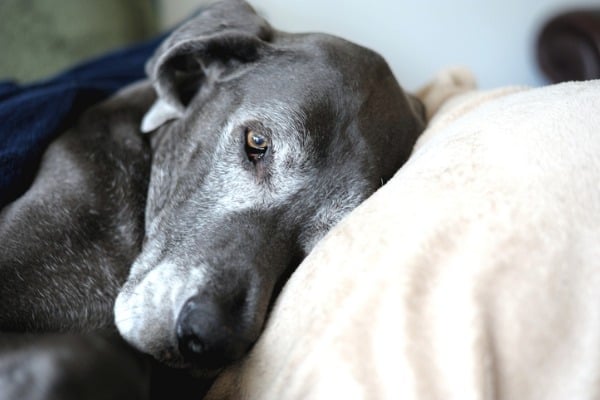
Now that we’ve narrowed down some reasons why dogs pace, you’ll want to know if there’s any way to scale back this behavior in your pet.
Get a Diagnosis and Proper Treatment
Whether it’s because of age or not, a professional must treat your dog’s injury or illness.
Your dog’s comfort is the most important thing – self-treating serious issues is not an option.
If you suspect arthritis or an injury, you should contact a vet to find out your next steps toward your dog feeling better.
Follow all vet orders, including restricting activity if need be.
Arthritis is a chronic condition, so your dog might be on pain management medication for the rest of their life. Be sure to medicate your pet as directed.
Once your dog is feeling more like themselves, the pacing should subside.
Pay Attention to Your Dog

Definitely shower your dog with as much attention as you can. But also, be aware of what they’re trying to tell you with their body language.
If nothing else seems abnormal, do a mental checklist of everything in their routine. Did they go out recently?
Or is it dinnertime? Did you spend enough time petting and playing with them today?
Is their favorite toy missing? If their prized stuffed puppy has gotten wedged somewhere, they could be asking for you to fetch it.
Sometimes just giving them attention can be beneficial.
Check on their bedding, and see if anything about it would make them not want to get comfy there. They could be pacing in search of a better place to rest.
Maybe their bed became wet or dirty. Or perhaps the cat stole it (because everyone knows cats can be bullies).
Get Your Dog Neutered or Spayed
An unaltered female dog will go into heat twice a year. If she’s agitated during her heat cycle, spaying her is an easy way to ease her stress.
An unaltered male will not only be extra hyper; he will mark his territory everywhere.
A dog pacing is the least of your worries when your dog is marking your furniture.
Both male and female dogs can benefit health-wise from getting fixed. Pacing is one of the many physiological issues solved by fixing them.
There are several health risks for dogs who aren’t spayed or neutered. You might save them from a lot worse than frequent pacing if you sterilize them.
Play Games With Your Dog
All dogs can become bored or understimulated, regardless of their breed. Pacing and FRAPs can be toned down by providing exercise and mental stimulation.
Dog brain teasers are a great way to engage your dog. It’s an excellent option for rainy days and apartment dwellers.
Make time for adequate walks. Outside time shouldn’t be reserved for eliminating only.
Allow your dog time to sniff and explore. Try to give them some time off-leash in areas where it is safe to do so.
Try To Reduce Stress

If your new baby is causing your dog to stress-pace, don’t get rid of the baby just yet.
We’re kidding – but on a serious note, there are ways to introduce a new family member that makes it easier for everyone.
The same applies to a new cat or dog siblings. Bombarding your dog with change is a quick way to stress them out.
If your dog has separation anxiety, pacing can be one of the signs. This type of anxiety can be difficult to cure, but not impossible.
You can condition your dog not to fear your absence. In extreme cases, your vet can recommend some medical or alternative supplement to ease stress.
Comforting Your Best Friend
Anyone who has ever owned or been around a dog knows what great companions and friends they can make.
These beautiful creatures bring us so much happiness and company. The hardest part of being a dog owner is holding it all together when they get sick.
Even though pacing can be synonymous with stress for you and your beloved dog, it doesn’t have to be the norm. There are plenty of options to reduce pacing, no matter the root cause.
Some potential causes require urgent medical care.
If you see signs of intestinal distress or sudden abnormal behavior in your dog, call your vet right away.
If you’ve noticed signs of arthritis or a possible injury in your dog, the vet is also your best choice. Some conditions require medical guidance to provide the best outcome.
Other causes for your dog’s pacing and won’t lie down symptoms can easily be remedied with extra love and attention.
And seeing your dog feeling more like themselves is worth all the extra time you share with them.
Between you and your trusted veterinarian, there are many methods to use to decrease pacing in your dog.

